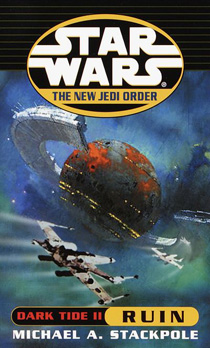On page 217 of “Dark Tide II: Ruin” (2000), Chiss Empire pilot Jag Fel outlines for Rogue Squadron pilot Jaina Solo the differences between them: It’s not that she’s not strong or skilled or smart, it’s that she’s not “grim.” That’s also the perfect word to describe my overall impression of “The New Jedi Order,” and this third book is where it starts to really get grim.
The first book of Michael Stackpole’s duology, “Onslaught,” was – in retrospect – one of the last pre-grim “Star Wars” novels, largely because it didn’t feature any Yuuzhan Vong perspective until the final chapter. “Ruin,” on the other hand, features a lot of point-of-view of Commander Shedao Shai as he outlines the death- and pain-oriented Vong culture to New Republic envoy Elegos A’Kla. Then he murders Elegos and sends his gold-plated bones back to the New Republic, conveying that the Vong revere death more than life and setting up the broad thematic thrust for the saga.
At the same time, this is still a Stackpole book – albeit his last one, unfortunately – so there’s also a lot of meaty character stuff and galactic politics to dig into. By the time of “Legacy of the Force,” Del Rey opted to make parallels to Earth and American politics whenever possible, but in “NJO,” there are still striking differences. Most notably, the Chief of State (Borsk Fey’lya), the military (led by Traest Kre’fey) and the Jedi (led by Luke) are not connected by any formal legal arrangements but rather by complex political threads.
The planets of the New Republic in the “NJO” – rather inexplicably – do not seem to have their own militaries. When Garqi is invaded by the Vong, some citizens are evacuated by the military and ships from neighboring systems and others stay to fight in a makeshift militia with some Jedi help. As recently as “The Corellian Trilogy,” we saw that at least one planet – Bakura – had a military. But the only militaries spoken of in the “NJO” are those of the New Republic and its new ally, the Imperial Remnant.
At a casual glance, one could assume the New Republic military and the member planets are like U.S. states, which contribute to the U.S. military but don’t maintain their own. But that’s not the case, because earlier in the “NJO” saga, the New Republic Senate declines to sanction military help to member planets. (Because of the non-legally binding relationship between branches of the government, Kre’fey and Luke help anyway.) By contrast, an invasion of any U.S. state is an invasion of the U.S., and the U.S. military is obligated to respond.
For unexplained reasons, at this point in the saga the New Republic has done a complete flip-flop from the Old Republic. Its forbearer didn’t have a military for most of its existence — member planets maintained their own, if they so wished — and now the New Republic has a central military and member planets don’t have their own.

My guess is that this is not a dictate of the New Republic, since there would be little point in joining or staying in the nation if you must give up your military yet aren’t guaranteed to be protected by the central military. My assumption is that the time of peace between the “Hand of Thrawn” duology and the Vong invasion caused planets to get complacent about maintaining their own forces.
Meanwhile, R.A. Salvatore and Stackpole make it clear that the central military has been cut back through the will of taxpayers during this time of peace. That’s yet another notable difference between the New Republic and the U.S., where the military industry has long-established schemes (such as spreading jobs among various states, this widening political support) for maintaining a gigantic military regardless of the will of a democratic plurality.
This makes logical sense: The New Republic military must simply be big enough to repel incursions by other nations (the Imperial Remnant, the Chiss Empire, the Yevetha and the Ssi-Ruuk). (Of course, there’s also the concept of asymmetric warfare to consider, but that drifts from the point.) An invasion from outside the galaxy is not considered to be a realistic fear.
Interestingly, Stackpole peppers in the idea that it should have been. He notes that the Chiss Empire – which barely communicates with its allies in the Imperial Remnant, let alone the New Republic — has been fending off enemies for years, and he implies that these battles might have been probes by the Vong. Throw in the fact from “Vector Prime” that C-3PO is able to translate Vong language because it’s close to a known galactic language, and the evidence is starting to mount that the Vong have been in the galaxy for a long time.
By the end of “Ruin,” Stackpole has clearly delineated reality from political reality. Corran Horn heroically risks his life to save the beautiful tree-covered planet of Ithor by killing Shedao Shai in a duel. But the Vong culture is not like the Yevetha, with one leader and tiers of loyal followers. Rather, there is plenty of infighting and maneuvering, just like in the Republic (sadly, that might’ve been the one point of commonality Elegos was struggling to find). Shai’s subordinate, Deign Lian — under the direction of a different Vong military leader, Tsavong Lah — then destroys Ithor by Vong-forming it. The New Republic PR machine and media need someone (rather than itself) to blame for the death of Ithor, and Corran fits as a good scapegoat.
This is the first time in the post-“Return of the Jedi” books that the New Republic itself – rather than merely having flaws – is an aggressive enemy of the truth. “NJO’s” grimness takes an even more unsavory step when Luke agrees to let Corran take on the role of scapegoat.
All of that having been said, the encroaching darkness of the “NJO” saga is not a reason to abandon it, because Stackpole delivers plenty of good character stuff. In addition to the budding Jaina-Jag romance – which will be central to the Legends timeline from this point forward – we also see the first spark of Jacen’s interest in finding another way to fight the Vong without having to sacrifice the truth or Corran’s good name.
“Ruin” also features characters I had forgotten about but who make an impact in this particular novel. I had criticized Stackpole for not building the character of Jaina’s wingmate, Anni Capstan, in “Onslaught,” but that actually makes her death more powerful here. After the fact, Jaina learns from Anni’s mom that Anni considered Jaina a great friend. While Jaina certainly liked Anni, she regrets that she didn’t get to know her better.
Likewise, Anakin finds a friend (the man-of-the-streets Chalco) and loses another (the Twi’lek Jedi Daeshara’cor, who – in a subplot I had forgotten – tries to track down old Imperial superweapons, such as a rumored Eye of Palpatine twin). Like Jaina, Anakin has been assailed by the loss of loved ones, and both are mere teenagers. The grimness isn’t my favorite thing about “NJO,” but characters like Jaina, Jacen and Anakin are.

